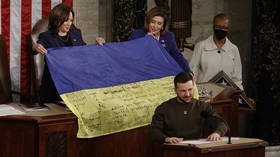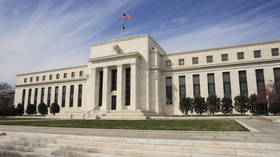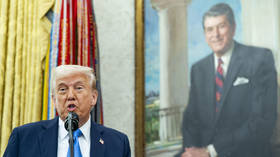Here’s why America’s usual approach isn’t working in Ukraine

The recent startling advance of Russian forces in northeastern Ukraine has dampened quite a bit of the enthusiasm in the pro-Kiev camp following passage in the US Congress of the supplemental aid bill in April. The febrile intensity with which supporters pleaded for the Ukraine aid, and the exaggerated importance they assigned to it, now seem a distant memory.
What is now clearer than ever is that Ukraine’s unravelling war effort cannot be fixed by simply switching the spigot of Western aid back on. So why did the Washington establishment treat the $60 billion figure as some kind of incantation that could ward off the looming crisis?
After all, much of the money won’t even end up going to Ukraine, but will rather be spent to restock the depleted domestic armory. This was in fact one of the key selling points of the bill – an economic boost at home. But greasing the wheels of the US’ lumbering defense industry won’t do anything for Ukraine’s beleaguered army anytime soon. Even after a herculean effort to ramp up production, the US now produces 28,000 155mm artillery rounds per month, not all of which can even be sent to Ukraine. Russia produces about 250,000 per month and fires, on average, 10,000 rounds per day.
And that doesn’t even address Kiev’s catastrophic manpower shortage and endemic corruption, both of which have been laid bare by Russia's recent advances. Kiev is having to play an ever more desperate game of whack-a-mole in deploying its tattered and stretched-thin forces to hold the front together, while the lack of fortifications around Kharkov are being blamed, even in the Ukrainian media, on the long-festering problem of corruption.
So we come back to the question of why anybody believed $60 billion could move the needle for Kiev’s cause in the first place. But this question is, alas, difficult to answer because policymaking in Washington is enshrouded under a thick fog that consists of two dominant components: magical thinking and political imperatives. For those who earnestly believed that $60 billion would turn the tide of the war, it is more of the former; for those aligning themselves with the political winds and pretending to support Ukraine much as a mime pretends to be trapped in a phone booth, it is the latter. In many cases it is both, and it is difficult to tell where one begins and the other ends.
Magical thinking is a recognizable symptom of that particular moment in time when an erstwhile great power is in decline but events have not quite yet forced it to come to grips with that decline. It is also a time of diminished scope for action. In times past, perhaps Washington would have solved a crisis such as Ukraine through crafty diplomacy or orchestrated a formidable proxy war with its industrial might and military expertise. But the US now seems incapable of sophisticated diplomacy and its industrial base has badly atrophied through decades of offshoring and financialization. After mostly fighting insurgencies in recent times, it now has no idea how to fight a peer war. About all that it can muster is aid bills with large dollar figures. If all you have is a hammer, the old saying goes, every problem looks like a nail. If all you have left is a printing press for dollars, then every problem must be solvable by an infusion of money – even if it’s not entirely clear what that money can buy.
But here we have stumbled onto something interesting: a belief in the omnipotence of money. Perhaps not a sincere belief; are there any sincere beliefs in Washington? Let’s think of it more as an ingrained pattern of thought for confronting a wide range of problems. In that sense, it is a framework suspiciously reminiscent of the approach used to combat financial crises. It doesn’t seem like so much of a stretch to imagine the entire Ukraine aid discussion framed as something that has become very familiar in recent years: a financial bailout.
A too-big-to-fail financial institution called Ukraine is teetering on the edge of failure and a bailout is needed. Although the bank is far away from the heart of Wall Street, there are fears of contagion – if this one fails, others will follow and soon no bank anywhere will be safe. The bank’s owners may be crooks, but that is not what is preoccupying policymakers. They are nervous about a spread that has suddenly moved against the bank: it is supposed to trade at 1:1 but has blown out to 1:10 (the ratio of artillery fire by Ukrainian and Russian forces). Shoving a $60-billion bailout into the bank should at least put out the fires and calm markets.
Zoltan Poszar, the legendary former Credit Suisse chief strategist who needs no introduction in finance circles, made a fascinating observation on the topic of the reflexive response of throwing money at a problem. Poszar was speaking narrowly about how a certain group of people approach a certain problem and was not talking about policymaking, much less Ukraine, but his conclusion traces the contours of something deeper.
When the specter of inflation reemerged in 2021, Poszar made the rounds of portfolio managers and, after talking with them, reached an interesting conclusion: nobody knew how to think about inflation. Nearly everyone on Wall Street is too young to remember the last serious bout of inflation, which occurred way back in the 1980s. So, according to Poszar, they all thought of the spike in the inflation charts as just another spread that blew out on their Bloomberg screens that could be solved by throwing balance sheet at it – a “crisis of basis” as he calls it. The formative experiences for today’s denizens of Wall Street, Poszar explains, are the Asian financial crisis of 1998, the Great Financial Crisis of 2008, some spread blowouts since 2015, and the pandemic. In all of these cases, money was pumped in and eventually the dislocations disappeared.
To put this in plain English, Poszar’s clients hadn’t encountered a problem that couldn’t be solved – or at least swept under the rug – by simply adding money, in whatever form, whether via an emergency loan or quantitative easing. This is of course a bit of an oversimplification, but it captures something of the essence of the prevailing pattern of thought.
However, as Poszar notes, the inflation of 2021 was a beast that could not be tamed by simply throwing money at it – or for that matter, even by merely hiking interest rates (merely a step removed from adding money). This made it an entirely unfamiliar type of problem for the current generation of fund managers and traders, he concluded. Indeed, perhaps what makes the problem of entrenched inflation so ominous is exactly that it is impervious to just about the only tool in the playbook: liquidity injections. That in itself is significant, but it is a topic for another day. For the sake of this discussion, let’s stick with the idea that the approach of solving problems by throwing money at them has become deeply ingrained.
Developing the same idea of throwing money at the problem of financial instability, but taking it in a different direction, was Timothy Geithner, the head of the New York Fed and then US Treasury secretary starting in 2009, who talked about dealing with financial crises by “putting a lot of money in the window” and, using a military analogy, bringing “overwhelming force” to bear so that markets believe the commitment is credible. This was the lesson learned from 2008, and it has since become a point of orthodoxy in dealing with subsequent crises. The stress experienced by the Treasury market in March of 2020 and the failures of First Republic Bank, Silicon Valley Bank, and Signature Bank in 2023 elicited an overwhelming response from regulators to shore things up.
Underlying this approach is an acknowledgement that markets can be driven by sentiment and that narrative can be just as important as substance. If markets believe the commitment – whether to propping up a bank, the Treasury market, or the repo market – is credible, things are less likely to spiral out of control. In other words, the art of addressing a financial crisis involves not only ponying up the money to close the basis but also shaping sentiment. There’s nothing particularly controversial about this. John Maynard Keynes talked about ‘animal spirits’ – the intuitive, emotional, and irrational components that economic decision makers bring to their actions. It thus follows that if investors start questioning the solvency of a market or institution, the path out of the woods is part finance and part PR. Geithner simply understood the true implications of this for confronting the increasingly frequent phenomenon of financial crises.
In watching how the US has managed its proxy war in Ukraine by sending an endless series of “strong messages” and making symbolic gestures, while prodding the Ukrainians toward actions imbued with more PR value than military benefit, it’s hard not to think that something of the Geithner approach has wormed its way into US policymaking, however subconsciously. At the very least, the $60 billion aid package was presented very much as a way to “reassure the market.”
Of course, the incessant drum beat of “strong messages” emanating from Washington can be seen in another light: as a flailing attempt to maintain American deterrence. Once established, deterrence is cheap to maintain, but it is very difficult and expensive to re-establish when lost. In a sense, these two ideas – deterrence and keeping animal spirits at bay – can be seen as two sides of the same coin. In both instances, it is an attempt to close the spread between reality and perception.
What is perhaps Washington’s most influential defense think tank, the Center for Strategic and International Studies, issued an article authored by analyst Max Bergmann in the days leading up to the congressional vote on the aid package that captures with exceptional clarity the emphasis placed on sentiment – called “morale” in this case.
“Passing the supplemental would likely sap Russia’s morale, in addition to boosting Ukraine’s,” Bergmann writes. And while he stops just short of predicting mass protests and the overthrow of President Vladimir Putin, he believes it will shake the foundation of the Russian political system and sow seeds of doubt into Russian society. The view that “this war makes little sense and was a mistake could spread like a virus and prove corrosive to the Russian system,” he concludes.
Where Bergmann falls on the ‘magical thinking’ versus ‘political imperatives’ continuum is unknown, but he seems to have internalized Geithner’s PR-tinged “credible commitment” principle, and he believes that will make all the difference.
Such is the thinking that has permeated Washington’s decision-making process in Ukraine. If finance is to the America of today what shipbuilding was to Holland in the 17th century – a dominant industry whose habits and patterns of thought seeped deep into the pores of the national consciousness – it shouldn’t come as a surprise that the framework for solving problems on Wall Street has implanted itself in other areas of policymaking. The foreign policy establishment, Congress, and Wall Street aren’t exactly the same thing, but they all seem guided by the same mental map.
Shelley wrote that poets are “the unacknowledged legislators of the world.” Perhaps the unacknowledged legislators of our time are the bankers and their friends in Washington who bail them out. Ukraine is learning the hard way that winning a war requires more than putting a lot of money in the window and running a PR campaign to keep the short sellers away.


















